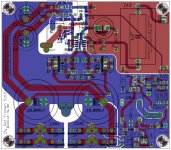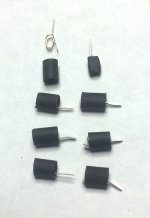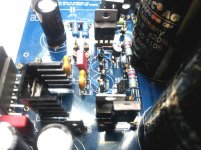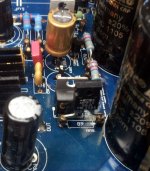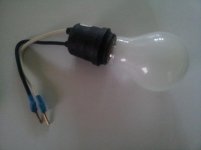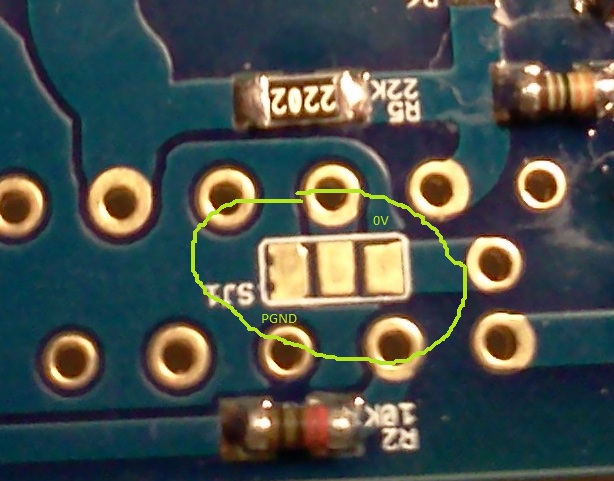In consort with Dario's "economy BOM" approach, I want to make sure I haven't overstated the importance of the large toroids. The cost considerations are key to building any amp and the cheaper, smaller ApexJr 125VA transformers were perfectly capable of supporting the FEs through the majority of my beta build. In fact that may be the most logical choice if users have bookshelf or smaller speakers.
I have gone for as many of the "optimum" components as I can afford to stay in the "spirit of the beta". My personal MyRef journey started with bare boards from Uriah and my own sourcing. Some have suggested that the MyRefs got off to a less than stellar start due to some incorrect component choices by early builders. Sticking with Dario's BOM can/will eliminate that fate for the FE, but I just wanted to make sure potential builders don't think they must go for broke (pun intended) to be able to hear the quality and impact of this design. 😉
😉
I have gone for as many of the "optimum" components as I can afford to stay in the "spirit of the beta". My personal MyRef journey started with bare boards from Uriah and my own sourcing. Some have suggested that the MyRefs got off to a less than stellar start due to some incorrect component choices by early builders. Sticking with Dario's BOM can/will eliminate that fate for the FE, but I just wanted to make sure potential builders don't think they must go for broke (pun intended) to be able to hear the quality and impact of this design.
 😉
😉
Last edited:
How does one access the BOM?
If I click the link I'm redirected to the Google Drive page and that's it.
Regards
If I click the link I'm redirected to the Google Drive page and that's it.
Regards
How does one access the BOM?
If I click the link I'm redirected to the Google Drive page and that's it.
No spreadsheet doc inside?
Try this link
Just to be sure I've attached all relevant files.
Attachments
Last edited:
O.K. Now I'm thoroughly confused.
With much fear and trepidation,I fired up the FEs with nothing in C102/202. It sounded surprisingly good (though not as refined) with more impact, cleaner definition and an apparent wider stage. Voices sound more forward and might need a lower volume setting to avoid overstatement.
It's late, I'm finished for the day and will listen more tomorrow -but- What's going on here Mr. Inserra ??? Maybe I should pull out a bunch more stuff for even better performance. 😀
With much fear and trepidation,I fired up the FEs with nothing in C102/202. It sounded surprisingly good (though not as refined) with more impact, cleaner definition and an apparent wider stage. Voices sound more forward and might need a lower volume setting to avoid overstatement.
It's late, I'm finished for the day and will listen more tomorrow -but- What's going on here Mr. Inserra ??? Maybe I should pull out a bunch more stuff for even better performance. 😀
Last edited:
With much fear and trepidation,I fired up the FEs with nothing in C102/202. It sounded surprisingly good (though not as refined) with more impact, cleaner definition and an apparent wider stage. Voices sound more forward and might need a lower volume setting to avoid overstatement.
Yes, I like very much how it sounds without caps.
It's late, I'm finished for the day and will listen more tomorrow -but- What's going on here Mr. Inserra ???
Those caps are not needed by the regulator for stability but they reduce a bit the remaining ripple.
Usually those decoupling caps are used on chips to give a low impedance supply, improving stability and performance.
Also those caps impart their sound signature to the opamp.
In this particular case the regulator already have a low impedance output and PCB traces to the opamp are very very short so they could be omitted.
Stability should be checked to be sure they're not needed but I don't have an oscilloscope to test it.
BTW it don't give any sign of instability.
The resulting sound is free of the sound signature of those caps.
I've been inspired by LCAudio's ZapFilter where a similar approach is used.
Maybe I should pull out a bunch more stuff for even better performance. 😀
Absolutely not! 😀
It's a very specific case.
could i try the same for myrefc boards or was the network changed for the fe?
It depends on how you routed connections but I wouldn't.
The FE boards have constant impedance traces that may have a role in stability
Yes, what I heard was indeed a very open and almost "untamed" presentation. For some music styles it may give an aggressive nature that fits well for that "live party" sound.
The most negative element in my short listening session was some raggedness at the end of some piano and vocal crescendos. One of the best features was the return of those musical/tonal elements embedded in ride cymbals in jazz and pop music.
I played several tracks from a lite opera disk and the solo voices came through with almost perfect "in the room" presence.
Finally received the True Copper caps (C13) yesterday just as I finished adding sockets in all the appropriate spots: C7, C10, C12, C13, C30, CC32 - R7, R12, R13, R101/201, R104/204. My intent is to test each location one at a time, note the change and report back if and when we (me and the amps) survive.

The most negative element in my short listening session was some raggedness at the end of some piano and vocal crescendos. One of the best features was the return of those musical/tonal elements embedded in ride cymbals in jazz and pop music.
I played several tracks from a lite opera disk and the solo voices came through with almost perfect "in the room" presence.
Finally received the True Copper caps (C13) yesterday just as I finished adding sockets in all the appropriate spots: C7, C10, C12, C13, C30, CC32 - R7, R12, R13, R101/201, R104/204. My intent is to test each location one at a time, note the change and report back if and when we (me and the amps) survive.


I forgot to add (Michigan Man Speak With Forked Tongue) those 300VA toroids are really kicking it. I wasn't aware there might be a burn-in for transformers, and maybe it's just the other components adjusting to the higher voltages/currents, but both the apparent SPL and the punch/power have improved with continued use. This thing is turning into a monster amp.
Also, I was still eight sockets short so I took Andrew's idea one step further and added a retaining sleve with some heat shrink tube. Still somewhat delicate but they work just fine.
Also, I was still eight sockets short so I took Andrew's idea one step further and added a retaining sleve with some heat shrink tube. Still somewhat delicate but they work just fine.
Attachments
Last edited:
The most negative element in my short listening session was some raggedness at the end of some piano and vocal crescendos. One of the best features was the return of those musical/tonal elements embedded in ride cymbals in jazz and pop music.
Can you point me to a song where I can experience that problem?
Finally received the True Copper caps (C13) yesterday just as I finished adding sockets in all the appropriate spots (...) My intent is to test each location one at a time, note the change and report back if and when we (me and the amps) survive.

Don't worry.
The only delicate positions are R104/R204 (you should wait a couple of minutes after power-off to let caps discharge), for all others as long as you swap components with the amp powered off 🙂D) you shouldn't experience any problem.
😀I have all the 100uF power decoupling caps removed from MyRef board.😀
So I suppose you verified that the LM318 was stable in TP boards... but you're using a SMPS.
Any progress with the FE build?
Also, I was still eight sockets short so I took Andrew's idea one step further and added a retaining sleve with some heat shrink tube. Still somewhat delicate but they work just fine.
You can also reuse sockets that you're using for the two MP915, you can solder them, they're the absolute best there.
Last edited:
Here you go!
A great sounding album with lots of solos and chorus. The peaks jump out on some of the heavier male vocal passages.
I've still got my safety rig, but thanks again for the warning.
A great sounding album with lots of solos and chorus. The peaks jump out on some of the heavier male vocal passages.
I've still got my safety rig, but thanks again for the warning.
Attachments
Thanks for the link 🙂
I've still got my safety rig, but thanks again for the warning.
You don't need it for those components swap...
I have not experienced any problems. What kind of problem would one expect? High frequency oscillations?...
So I suppose you verified that the LM318 was stable in TP boards... but you're using a SMPS.
Any progress with the FE build?
....
Just about finished on some other stuff this week, which is testing the modified active speakers. Once those get to the people responsible for relaying out the boards, I will have time to get back to the MyRef and FE to play around with.
Haven't gotten to the FE yet. When I last left off I was trying to mod the current gain of MyRef and experienced a slow DC drift to max; that was when I discovered the new resistors I put in were not 0.1%. But I do have the right tolerance ones on hand now. So I will return to where I left off and continue. The competition bar has been raised since my active speakers are improved, and I already have some feeling as to where I would like to see the MyRef and FE mods excel.
Packages shipped.
You'll find, apart PCBs, Elnas, zeners and partial kits (for whom asked them) also some thin solder (Sn/Pb/Ag) for SMD soldering.
I've highlighted with white paint the manifacturer 'fixes' on PCBs, take maximum care on that sections, consider them as without the solder mask and after soldering check with a multimeter for shorts.
The ground plane connections are more difficult to solder, thermals width too large (it will be fixed in the final boards). Use a higher soldering temperature on those.
Don't forget to short LM3886's ground to PGND or 0V using a solder bubble on the solder jumper (see attachment).
Please let me know when packages arrive.
which side is PGND ? Which one are you using McBob ? ( or should I say BayCity, next he will call me JoeBama)
I would like a spot in the group buy for boards.
I also wonder if you would get a better response if you started a thread in the group buy forum?
randy
I also wonder if you would get a better response if you started a thread in the group buy forum?
randy
- Status
- Not open for further replies.
- Home
- Amplifiers
- Chip Amps
- My_Ref Fremen Edition - Beta build/Fine tuning
